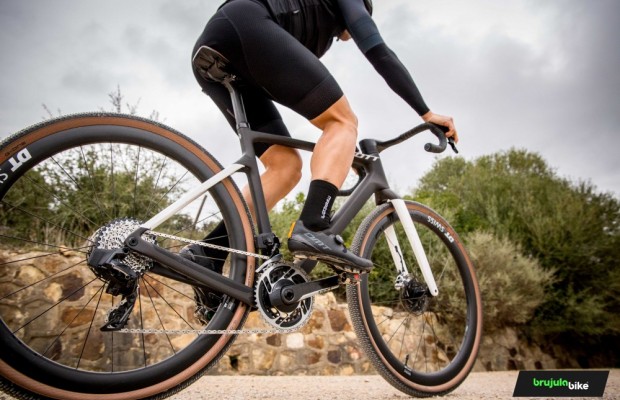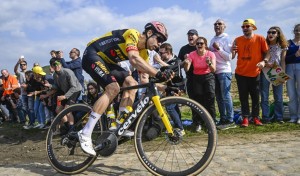Paris-Roubaix was won again with an aero bike
Although the brands usually have models specifically created for a race as special as Paris-Roubaix, the truth is that, when it comes down to it, cyclists opt for the most effective bikes, which in many cases are the same ones they use all year round. A clear example is the Canyon Aeroad CFR on which Mathieu van der Poel won, except for the tyres used, which are identical to the one he normally uses.

Mathieu van der Poel didn't need specific equipment to triumph in Roubaix
Every year, when Paris-Roubaix comes around, lots of pages are filled with talk about the specific bikes for this race or the technological innovations that the teams apply to them. In this edition, the spotlight was on the tyre pressure adjustment system used by some Team DSM and Jumbo-Visma riders.
Surprisingly, a flat tyre in the Arenberg forest sector ended the chances of Christophe Laporte, one of the Jumbo-Visma riders who had mounted the Gravaa KASP system on his wheels, leaving Wout van Aert without a vital support when entering the decisive phase of the race. Subsequently, another flat tyre in the decisive Carrefour de l'Arbre left Van Aert himself, although he did not use the pressure adjustment system, out of contention for the victory.
RECOMENDADO

Change wheels if you want to transform your bike's behavior

What bike size do you need? Here's how to find out

How does age affect performance and recovery?

10 tips for safer and faster downhills on road bikes

The best gravel groupsets of the moment

How to lose body fat? Differences between losing weight and losing fat

Until a few years ago, Paris-Roubaix-specific bikes were another dominant feature. Machines with a longer geometry between axles and a higher riding position, as well as a design with specific absorption zones to reduce the impact of the cobblestones as much as possible. Some are still using these specific models as in the case of some Trek-Segafredo riders who have at their disposal the Domane model, the teams that use Specialized: Soudal-QuickStep, Bora-Hansgrohe and TotalEnergies that can benefit from the Roubaix and its curious suspension system in the head tube, or the Cervélo Caledonia used by the Jumbo-Visma riders.
However, if we go to the top of the classification we see that Mathieu van der Poel used the same Canyon Aeroad CFR with which he has competed all season, a purely aerodynamic model with 100% sporty geometry. A bike that, despite this concept, has always boasted a remarkable absorption capacity, especially compared to Canyon's other competition bike, the Ultimate, where achieving maximum stiffness in order to be more effective in climbing is the key parameter.

A closer look at Mathieu van der Poel's bike shows that the tubeless tyres chosen, a Vittoria Corsa Pro but in 700x32c size compared to the 28 mm he has been using during the rest of the cobblestone classics, are the only modification that the Dutchman has made on his bike to deal with the very hard pavement of Paris-Roubaix. No special position or those tricks that were traditionally used, such as double handlebar tape for extra cushioning.
Moreover, Mathieu didn't even wear gloves during the race, a preference of many classics riders for a better handlebar feel and which shows that more important than the material is the correct technique when riding on the pavé.

His teammate Philipsen, who took the second step of the podium also used the same bike with a similar configuration while Wout van Aert, who had to settle for third place, did use Cervélo's gran fondo model, the Caledonia. If we go to fourth place, where we find Mads Pedersen, it is curious to note that he opts, despite having at his disposal the efficient Domane from Trek, for the aerodynamic model Madone, the same machine he uses throughout the year, like his rivals with the only modification of tubeless tyres with a larger section, in his case, Pirelli. We also found aero bikes in other protagonists of the race as John Degenkolb, with his Scott Foil RC or Filippo Ganna riding his usual Dogma F despite the fact that in the past the Italian firm experimented with a model with a small rear suspension.

It should not be forgotten that Paris-Roubaix is a race of 254 kilometers of which only a little more than 50 are on cobblestones and where the speed is very high throughout the race as evidenced by the new speed record set by Van der Poel at just over 46 km/h on average, speeds at which aerodynamic gains are of great importance when it comes to saving watts. This is why many prefer to sacrifice a certain degree of comfort on the cobblestones for the advantage that the bike and the aerodynamic wheels can give them at such speeds.